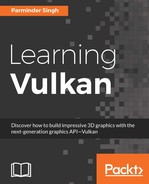Implementing textures is easy and requires only a few steps. Let's have a quick overview of this first, then we will take a deep dive into it:
- Texture coordinates: Textures are glued to the geometry surfaces using texture coordinates. For each vertex, there is a corresponding texture coordinate attached. In our implementation, we specified the vertices and texture coordinates in an interleaved form.
- The shader stage: The vertex and fragment shader are modified to bound the texture resources. The shader stage allows the fragment shader to access the texture resource and paint the fragments. Textures are shared in the form of a sampler at the shader stage.
- Loading the image files: Parse the image files and load the raw image data into the local data structure. This will be helpful in producing Vulkan image resources and sharing them at the shader stage.
- Local image data structure: The
TextureDatalocal data structure stores all the image-specific attributes.
The geometry coordinates (x, y, z, w) are interleaved with texture coordinates (u, v) in the VertexWithUV structure defined in MeshData.h:
struct VertexWithUV
{
float x, y, z, w; // Vertex Position
float u, v; // Texture format U,V
};
In this present sample, we will render a cube drawn with textured faces. The following code shows one of the cube faces with four vertex positions followed by two texture coordinates. Refer to MeshData.h for the complete code:
static const VertexWithUV geometryData[] = {
{ -1.0f,-1.0f,-1.0f, 1.0f, 0.0f, 1.0f }, // -X side
{ -1.0f,-1.0f, 1.0f, 1.0f, 1.0f, 1.0f },
{ -1.0f, 1.0f, 1.0f, 1.0f, 1.0f, 0.0f },
{ -1.0f, 1.0f, 1.0f, 1.0f, 1.0f, 0.0f },
{ -1.0f, 1.0f,-1.0f, 1.0f, 0.0f, 0.0f },
{ -1.0f,-1.0f,-1.0f, 1.0f, 0.0f, 1.0f },
. . . .
// Similar, specify +X, -Y, +Y, -Z, +Z faces
}
In addition to the vertex coordinates, now our vertex shader will also take the texture coordinates under consideration. The input texture coordinates are received at the layout location 1 in the inUV attribute. These coordinates are then passed on to the fragment shading stage and received in outUV. The following code shows the modification in the existing vertex shader in bold:
// Vertex Shader #version 450 layout (std140, binding = 0) uniform bufferVals { mat4 mvp; } myBufferVals; layout (location = 0) in vec4 pos; layout (location = 1) in vec2 inUV; layout (location = 0) out vec2 outUV; void main() { outUV = inUV; gl_Position = myBufferVals.mvp * pos; gl_Position.z = (gl_Position.z + gl_Position.w) / 2.0; }
The following code implements the fragment shader where the sampled texture is received at the layout binding index 1. The received texture is used with the input texture coordinates to fetch the fragment colors:
// Fragment Shader #version 450 layout(binding = 1) uniform sampler2D tex; layout (location = 0) in vec2 uv; layout (location = 0) out vec4 outColor; void main() { outColor = texture(tex, uv); }
The image files are loaded in our sample application using the GLI library. OpenGL Image (GLI) is a header-only C++ image library that supports the loading of KTX and DDS image files for a graphics software application. It provides various features such as texture loading and creation, texture compression, accessing of the texture texels, sample textures, convert textures, mipmaps, and more.
You can download this library from http://gli.g-truc.net/0.8.1/index.html. In order to use this library, perform the following changes:
- CMakeLists.txt: Add GLI support by adding the following lines to the project's
CMakeLists.txtfile:
# GLI SETUP
set (EXTDIR "${CMAKE_SOURCE_DIR}/../../external/gli")
set (GLIINCLUDES "${EXTDIR}")
get_filename_component(GLIINC_PREFIX "${GLIINCLUDES}" ABSOLUTE)
if(NOT EXISTS ${GLIINC_PREFIX})
message(FATAL_ERROR "Necessary gli headers do not exist:
" ${GLIINC_PREFIX})
endif()
include_directories( ${GLIINC_PREFIX} )
- Header files: This includes the header files for GLI in the
Headers.hfile:
/*********** GLI HEADER FILES ***********/
#include <gli/gli.hpp>
The following code is the minimal usage of the GLI library in our application. This code demonstrates image loading, the querying of a dimension, mipmap levels, and the retrieval of image data:
// Load the image const char* filename = "../VulkanEssentials.ktx"; gli::texture2D image2D(gli::load(filename)); assert(!image2D.empty()); // Get the image dimensions at ith sub-resource uint32_t textureWidth = image2D[i].dimensions().x; uint32_t textureHeight = image2D[i].dimensions().y; // Get number of mip-map levels uint32_t mipMapLevels = image2D.levels(); // Retrieve the raw image data void* rawData = image2D.data();
The wrapper.h contains a user-defined TextureData structure to hold the image attributes and various pieces of image-specific information in the application. The following is the syntax and description of each field:
struct TextureData{
VkSampler sampler;
VkImage image;
VkImageLayout imageLayout;
VkMemoryAllocateInfo memoryAlloc;
VkDeviceMemory mem;
VkImageView view;
uint32_t mipMapLevels;
uint32_t layerCount;
uint32_t textureWidth, textureHeight;
VkDescriptorImageInfo descsImgInfo;
};
The following table describes the various fields of the user-defined structure, TextureData:
|
Parameters |
Description |
|
|
This is the |
|
|
This is the |
|
|
This contains specific implementation-dependent layout information of the image resource object. |
|
|
This stores the memory allocation information bound with associated image object ( |
|
|
This refers to the physical device memory allocated for this image resource. |
|
|
This is the |
|
|
This refers to the number of mipmap levels in the image resource. |
|
|
This refers to the number of layer count in the image resource. |
|
|
These are the dimensions of the image resource. |
|
|
This is the descriptor image information that contains the image view and sample information with proper image layout |
In the next section, we will start implementing our image resource and see it in action.
